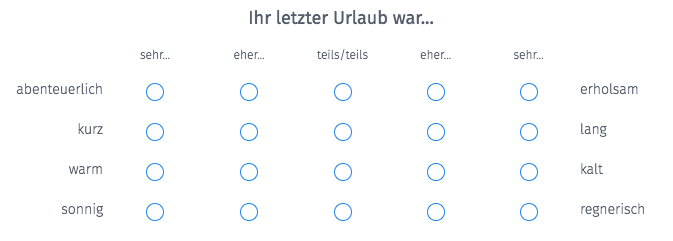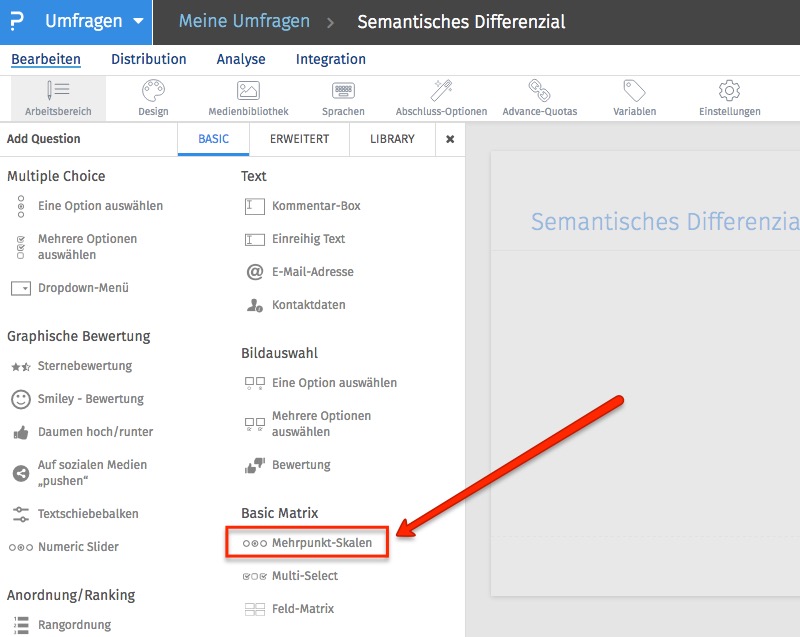Market research
With the QuestionPro market research software, you can put the “Semantic Differential” question type into practice quickly and easily, without any additional programming. You will also receive an attractive evaluation of the semantic differential.
Semantic differential
- 1 Definition: Semantic differential
- 2 The stacking scale
- 3 Example of a Semantic Differential
- 4 Example of a stacking scale
- 5 QuestionPro example questionnaire with the question types Semantic Differential and Stacked Scale
- 6 Try the software for creating and implementing the Semantic Differential now for free!
Definition: Semantic differential
The semantic differential, also known as the polarity or polarity profile and, more rarely, the impression differential, was originally a scaling procedure at the end of the 1950s to find out which attitudes or feelings people associate with certain objects, things or circumstances. Here, test subjects are presented with opposite pairs of adjectives for a specific term, such as “automobile”, such as loud-quiet, safe-unsafe, clean-dirty, on a usually 5-point scale with a neutral point, whereby test subjects then have to decide on one expression. The Semantic Differential was developed by the American psychologist Charles Egerton Osgood and was used in attitude research as a method for the quantitative analysis of affective word meanings. Today the semantic differential has a wider range of applications, for example in market research or customer surveys.
The stacking scale
A stacking scale, also known as a stacking scale, is a rating or measurement scale that has been known since the early 1950s and is similar to the semantic differential, but the stacking scale does not contain bipolar anchors. The stacking scale also always contains an even number of answer options without a neutral point. The stacking scale often contains 10 answer options, which are limited to a rating of -5 to +5. However, there are also many different variations, such as 8, 6 or even just 4 versions. With the semantic differential, the middle answer option is always the neutral point, which does not exist with a stacked scale. In addition, the stacking scale explicitly allows negative ratings. The Stapel scale was named after its developer, Jan Stapel, a Dutch social researcher and co-founder of the survey institute NIPO.
Example of a Semantic Differential
In the Semantic Differential, there are pairs of words or adjectives with opposite statements at both poles of the scale. To illustrate this, here is a very simplified example:

Example of a stacking scale
In contrast to the Semantic Differential, the stacking scale is unipolar and has an even number of answer options, so it determines intensities rather than polarities.

QuestionPro example questionnaire with the question types Semantic differential and stacking scale
To create a semantic differential or a stacked scale, you use the question type of the matrix question in the web-based market research software QuestionPro, namely the multi-point scale. This question type is already included in the free basic version of QuestionPro.
For a semantic differential, use the “Radio” setting in combination with the “Bipolar” variant; for the stacking scale, use the “Likert” variant. It's best to try it out for yourself!
And here you can find the Semantic Differential
as well as a sample questionnaire for the stacking scale.
Try the software for creating and implementing the Semantic Differential now for free!
If you have any questions about the Semantic Differential or the QuestionPro question types in general, we look forward to talking to you! Try QuestionPro now for 10 days free of charge.
Test the agile market research and experience management platform for qualitative and quantitative data collection and data analysis from QuestionPro for 10 days free of charge
SHARE THIS ARTICLE
FURTHER INFORMATION
- Conduct quantitative and qualitative market research with QuestionPro (Qual & Quant)
- Market research: examples, tips, data collection, data analysis, software
- The big QuestionPro guide on the subject of customer surveys: definition, development, methods, examples, evaluation, templates
- Semantic differential, conjoint analysis, maximum difference scaling and more
- The big QuestionPro guide on the subject of customer surveys: definition, development, methods, examples, evaluation, templates
- Market research news and trends from QuestionPro





